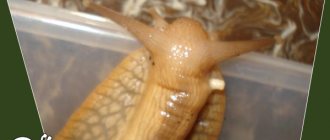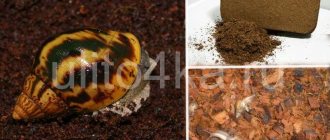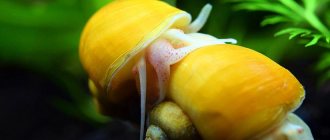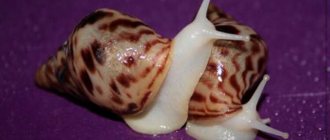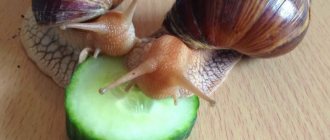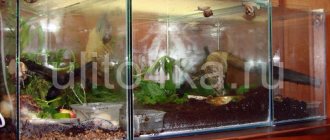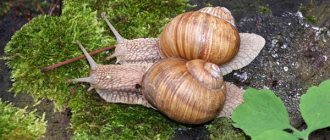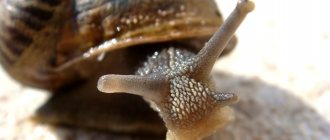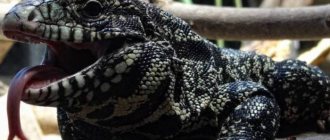- Wild animals
- >>
- Other animals
Giant Achatina is the largest representative of the Achatina family. These snails can grow up to 25 cm in length. In most countries, they are considered dangerous pests and the import of these snails into the United States, China and many other countries is strictly prohibited. In our country, these snails cannot live in their natural environment because the climate is too cold, so they are allowed to be kept as pets. These snails are also grown for use in cooking and cosmetology.
Turkish snail | 4-6 cm
Turkish snail , much more often called the mountain snail. It’s just that this species was described for the first time in Turkey. In general, this gastropod lives in the mountainous regions of southern Europe, Asia Minor, the Caucasus, and Crimea. That is, this snail can be called the largest of the Russian ones. Its lifestyle is similar to the South American scutalus. Prefers river valleys and stream surroundings. During drought it can fall asleep. It is one of the largest in Europe, especially in the Middle East (where humidity is not very good). The diameter of the shell is 4-6 cm.
Behavior
Achatina are predominantly nocturnal, although in wet weather they can crawl out during the day. Usually, they spend daylight hours in secluded places, burrowing into the soil and becoming active only two hours after sunset.
Achatina has been proven to have long-term memory: they can remember everything that happened within one hour, they can remember the location of food sources and return to them.
Young individuals are more mobile and cover long distances during the day, and are also capable of long-distance migrations. Usually they do not return to the same place to relax. Old snails, on the contrary, have a place where they prefer to rest and from where they crawl out in search of food, without moving more than 5 meters away. When the snails are transferred to the resting place of another Achatina (within 30 meters), they still return to theirs.
Grape snail | up to 9 cm
The indigenous European grape snail is smaller in size than the two species described above, but is clearly a record holder among northern species: the leg (body) can stretch up to 9 cm. The “house” is large, twisted counterclockwise. Not exotic. Agricultural pest. The headache of winegrowers. However, it feeds on the shoots of not only grapes, but also other garden plants. But you can take revenge on her by eating! In the territories of modern Italy and France, it has been bred as a delicacy since ancient times. Since it is consumed as a food product, it is dangerous to human health (very vulnerable to various parasites).
“Vinogradka” is unpretentious, lives long (up to 5 years, the record for keeping it at home is 30 years!).
Mr. Tail Recommends: Aquarium Basics
In addition to the snails themselves, you also need to purchase a terrarium, soil (moss with sand or peat) and a bowl for water. The volume of the aquarium should not be less than 20-25 liters for a pair of pets.
The tank should have a lid with small holes - such as to provide an influx of fresh air, but not allow the mollusk to get out.
The aquarium needs to be cleaned at least once a month. At this moment, the snails themselves can be bathed - placed in a basin of water for a while, but do not fill the container to the brim, but about a quarter, so as not to kill the pets.
It is recommended to bathe Achatina more often than once a month. You cannot add any additional products - only clean water.
A bowl of water (it is advisable to place several: a large one as a pool and a small one as a drinking bowl) should be renewed twice a day. In addition, several times a day, to maintain humidity, unique water procedures should be carried out: release a dozen jets of water over the inner surface of the aquarium from a spray.
It must be remembered that Achatina are tropical inhabitants, so the terrarium must be warm. This does not mean that it is necessary to install heaters, it is enough to maintain room temperature. +23…+26 °C and high humidity will be comfortable for pets.
Excessive dampness is also useless. In this case, Achatina will crawl up the walls, trying to leave the tank. If they are too dry, they will burrow into the substrate. Under optimal conditions, giant snails quietly crawl along the bottom during the day, and at night they dig a little into the filler, hide in the shell and sleep.
Tropical woody | 5-9 cm
Tropical tree (Caracolus sagemon), native to Central America. A distinctive feature is an unusual flat striped orange-black shell, twisted counterclockwise, externally reminiscent of a variegated inverted cup or a pyramidal pebble (the name of the species from Latin). Different body color options give a very beautiful coloring, for which snails are very loved by those who keep them at home. Exclusively vegetarian (except for foods containing calcium), a lover of open water (literally swims). Feels better around people like you. As for size, it is very dependent on nutrition and living conditions. When everything is just wonderful, Caracolus can be considered a giant, growing up to 15 cm. But this happens rarely, the usual leg length is 5-9 cm.
The largest snail in the world - what is it and where does it live?
Today, no one is surprised by the presence of a mollusk as a pet. At the same time, small species of gastropods are gradually losing popularity among lovers of exotic animals.
Among the representatives of aquatic and land mollusks, there are the smallest species, and very large, giant ones. Many people are interested in the name of the largest snail in the world, and whether it can live at home.
Let's talk about everything in order.
Helix
The Bukha Vineyard snail (Buchi) has a shell height of 4.5 to 6 cm. It is a rather rare species of land mollusks that lives exclusively in the Caucasus, in the southwestern part. During Soviet times, the Helix buchi snail was protected by law. This was evidenced by the entry in the Red Book of Endangered Species of Animals.
The snail Helix pomatia is the largest representative of gastropods in Europe. Its shell reaches 4.5 cm, and it weighs about 45 grams.
Grape snails are considered a gourmet food product. The French consider them their national dish, so they are served in almost every restaurant. For this reason, few of them remain in the wild.
To meet consumer demand for snail meat, they began to be raised on specially created farms.
The homeland of the snail Helix aspersa maxima (Gros - Gris) is considered to be North Africa. It can be found very rarely in natural conditions on the European continent. The shell of an adult specimen grows up to 4.5 cm and weighs 40 grams. It may not be the largest snail in the world, but its size is impressive.
The meat of this snail contains many useful microelements, including protein, zinc, calcium, copper, etc., so it is highly valued by lovers of exotic cuisine.
A use has also been found for the protective mucus of the African mollusk Gros – Gris. It is widely used in cosmetology due to its high content:
- collagen,
- elastin,
- allantoin,
- glycolic acid,
- and a whole set of vitamins.
The presence of natural antibiotics in the mucus of the Helix aspersa maxima snail, along with other components, makes it a unique remedy that can cure dermatoses and other skin diseases. It is also used in the fight against tuberculosis and asthma.
The natural habitat of Turkish snails is the Balkan Peninsula. The mollusk Helix lucorum is one of the largest representatives of gastropods. Its size can reach 4.7 cm and weigh up to 25 grams. Literally translated from Latin, Helix lucorum sounds like “forest curl.” But this name was not widely used. More often this mollusk is called Turkish or mountain.
Megalobulimus
The largest domestic snail, whose homeland is Central America (forest tropics) and part of the Caribbean islands, is Megalobulimus. Its dimensions reach 11 cm, and the shell is beautifully twisted and has a rather sharp top. In adult individuals, the color of the shell changes from brown to whitish or light beige.
Compared to other mollusks, Megalobulimus are considered long-lived, as they have a lifespan of up to 15 years.
Achatina achatina
The largest snail, Achatina, which is also called the tiger clam, is a representative of land gastropods, having gigantic dimensions by snail standards. An individual was found with a total size of 39.9 cm with a shell length of 27.3 cm.
This clam weighs 900 g and has excellent stretch. He managed to extend his “leg” further than others, thanks to which he entered the book of records. Representatives of the Guinness Book measured all the parameters of this Achatina, after which they recorded a record.
An equally famous mollusk of this species was found in 1976 in Sierra Leone (west Africa). Its overall size was 37.5 cm with a shell length of 27.5 cm and a weight of about 1 kg. This tiger snail is described in the literature, but has no documented evidence of its existence.
By searching for the largest snails photo, you can see that tiger Achatina has an orange shell with dark stripes. This color resembles brindle, which explains the origin of its name.
African Achatina reaches gigantic sizes due to its good appetite. They eat everything, including the plaster on the walls of buildings. It is common among African peoples to eat the meat of these snails. In Europe, they are kept only as pets.
Florida horse snail
This is a fairly large water snail with a shell up to 60 cm. This mollusk was called a horse due to its impressive size. Its natural habitat is the waters of the Atlantic.
Snail is a record holder
One of the famous aquatic mollusks, the giant Australian Trumpeter weighs 18 kg with a shell height of 91 cm. The home of this super mollusk is the waters of the World Ocean. An individual was found whose size is 110 cm. You can recognize this giant by its five-turn orange shell, which becomes darker as the snail ages.
The trumpeter is a predatory creature that feeds not on plants, as is usually the case with snails, but on sea worms and animal corpses that are found on the bottom. Science still knows only one species of predatory mollusks that hunt living creatures.
Limicolaria fiery | up to 10 cm
Limicolaria flammea is African, but has also spread to the Asian tropics. Wears a tubular shell. She wears it exactly: sometimes it rises so high above the leg that it seems like some kind of appendage. Prefers a nocturnal lifestyle. Unpretentious. You can’t say about her: “Slow, as everyone knows.” Just the opposite: fast, with some kind of cat-like agility. Therefore, for an inattentive owner, this beautiful gastropod creature with black and red outlines on the shell can famously “leak” from the terrarium. Grows up to 10 cm.
Scootalus | up to 10 cm
Scutalus, the owner of the “author’s” (its shape is very unusual) shell, lives on the shrubs of the rocky plains of the Peruvian Highlands. There is not much humidity here, but it is not very important for the scutalus. Dimensions up to 10 cm. The unusual shape attracted the attention of artisans of the ancient Mayans: decorative items were found using the “house” of scutalus, not to mention simple beads.
Achatina giant | 5-10 cm
The Latin name ( Achatina fulica ) already indicates that it is fulica - gigantic. The average size is 5-10 cm. Specimens up to 20 cm have been recorded. Naturally, the older it is, the larger it is.
East Africa is considered the homeland of the largest land mollusk (that is why it is also called the African giant mollusk). It did not survive in the north, but where the climate is close to its native one, it thrives. For local residents it is not exotic. They even fight her! She is a pest, which is due to her terrifying appetite for crops. He especially loves sugar cane. Moreover, the greatest harm is caused by juveniles, which prefer fresh plants.
Over time, the elders switch more and more to rotting products, sometimes they do not even disdain the corpses of animals. They love darkness and humidity. They lead a midnight lifestyle, but when it is cloudy, they can go out to eat during the day.
Social structure and reproduction
Photo: Giant Achatina snails
Achatina are convinced loners. Snails spend most of their lives alone; sometimes snails can live in pairs. They don’t build families, and mollusks don’t have any social structure. Sometimes snails can live in pairs. In the absence of a partner, Achatina, as hermaphrodites, is capable of self-fertilization. Since all Achatina are hermaphrodites, their females are larger individuals, this is due to the fact that laying eggs and forming a clutch takes a lot of effort, and weak individuals cannot cope with this mission. If large-sized individuals mate, then double fertilization is possible. Snails reach sexual maturity between six months and 14 months.
Mating in giant African snails occurs like this: a snail that is ready to reproduce crawls in circles, slightly lifting the front part of its body forward. The snail crawls slowly, sometimes stopping; when they meet the same snail, they begin to crawl in circles, feel each other and communicate. This acquaintance lasts for several hours. Afterwards, the snails firmly adhere to each other. One mating is enough for a snail to lay several clutches. For almost two years, the snail will use the resulting sperm to fertilize new eggs.
Giant African snails are extremely prolific, laying 200 to 300 eggs at a time. The snail forms its clutch in the ground. She digs a hole about 30 cm deep; with her shell she forms the walls of the hole, compacting them so that the soil does not collapse. After which the snail lays eggs. The formation of masonry takes quite a long time and takes a lot of effort. Some snails, after laying eggs, can be so exhausted that they die without leaving the hole.
When oviposition is favorable, the female leaves the burrow, closing the entrance to it. The snail no longer returns to its offspring, since small snails, having hatched from the egg, are capable of independent life. The eggs of giant Achatina are somewhat similar to chicken eggs, they are the same shape and color, only very small, about 6 mm in length, covered with a strong shell.
An egg consists of an embryo, white and shell. The incubation period is from 2 to 3 weeks. When a snail hatches from an egg, it eats its egg, digs out from the soil and crawls out. During the first years, snails grow very quickly. By the end of the second year of life, the growth of snails slows down significantly, however, adults continue to grow.
Interesting fact: If little snails are disturbed or frightened by something, they begin to squeak loudly and crawl in circles. Adults are calmer and do not behave this way.
Florida horse snail | 60 cm
An obligatory character in photographs of the largest snails in the world. It is similar to the Australian trumpeter, although it is inferior in size (60 cm). However, in terms of size, it is the champion of both Americas. It lives along the American Gulf Coast. It lives in shallow water, like the whelk, but is an even more aggressive predator: it eats not only worms, but almost everything it can. Other smaller “horses” too.
It has a very striking appearance due to the incompatibility of colors: a bright orange body and a gray shell. It seems that this frightens those inhabitants of shallow waters, which can themselves eat the “horse” while it is small. Our heroine’s “house” is always unique in shape, and therefore is a valuable trophy for divers as a souvenir. Those who are particularly keen even eat it!
Features of care
As mentioned above, Achatina are ideal pets for lazy owners, since they require minimal care. But certain subtleties still exist.
Feeding
Achatina is not picky about food
Achatina happily eats greens, vegetables and fruits, although in natural conditions they do not disdain meat. Feed is given as it is eaten, and leftovers must be removed regularly. In captivity, snails are given cabbage, cucumbers, and carrots. This is a standard diet, which, however, is better to diversify.
It is known that each individual snail has its own gastronomic preferences. Therefore, you will need to identify them experimentally.
So, among the permitted products for Achatina are the following:
- Fruits and berries: apples, cherries, strawberries, apricots, watermelon, figs, plums, pineapple, mango, avocado, bananas, strawberries, pears, melon, grapes.
- Vegetables: broccoli, pumpkin, carrots, rutabaga, tomatoes, lettuce, zucchini, celery, champignons, cucumbers, spinach, cabbage.
- Legumes and peas.
- Greens: meadow plants, clover, daisies, nettles, elderberry and fruit tree inflorescences, sprouted oats, dandelion, yarrow, plantain, alfalfa.
- Other: softened bread, fermented milk products (without salt, sugar and spices), low-fat minced meat, boiled egg, baby food (vegetable and meat), gammarus.
Important! Plants should not be picked within the city or factories, wastewater, or landfills.
List of prohibited products for Achatina:
- Everything is spicy and salty.
- Fried or smoked foods.
- Pasta.
- Sweets.
- Acidic foods.
To form a shell, Achatina needs calcium. Its lack in the diet leads to deformation and softening of the shell. In captivity, a snail can obtain calcium from eggshells, sepia, shell rock, food chalk and gammarus.
For quick results, you can prepare a special composition. Calcekasha is a special nutritional mixture made from various sources of this element. It is prepared in the following proportions:
- grain mixture – 70% (millet, flax seeds, oats, barley, wheat);
- eggshells – 3%;
- wheat bran – 5%;
- fish food – 5%;
- tricalcium phosphate – 12%;
- gammarus – 5%.
Along with food, there should be drinking water in the terrarium. It is needed for mucus secretion.
Video: feeding Achatina
Bathing: how and how often
Achatina loves water procedures
Achatina loves to swim. For owners, this is an additional way to establish contact with their pet. The procedure is carried out under a tap or shower, but always in warm water. The pressure can be adjusted by monitoring the behavior of the snail. If Achatina is unhappy, she will definitely hide in the shell.
Video: Tutorial for bathing a snail
Giant Australian trumpeter | 90 cm
The name reflects the appearance. The “house” looks like a large forge about 90 cm long. Therefore, I would like to call the trumpeter with the more respectable word “mollusk”. It lives off the northern coast of Australia, the shores of the nearest islands of the Indonesian archipelago. Lives in shallow water. Color: sand. Predator - a thunderstorm of sea worms. Judging by the fact that trumpeters gain up to 18 (!) kg of weight, they eat a lot of worms.
Culinary delights
In our minds, snails are no less strongly associated with France than frog legs, Bordeaux or baguette. Although Roman legionnaires took grape snails with them as food on campaigns. In this way they came to France, Britain, Germany, where they were liked by local residents, and in France they became a national dish. In the Middle Ages, Catholic monks loved to feast on snails during Lent, growing them in special cabbage beds at monasteries. Thanks to this, they easily endured fasting - snail meat is very nutritious and contains a third more protein than a chicken egg. In addition, snail is one of the aphrodisiac foods.
Snails in French
With increased interest in French culture among the Russian aristocracy, grape snails appeared in noble and landowner estates, brought from Western Europe more than two hundred years ago. Even now, based on the presence of colonies of grape snails, one can judge that there was once a noble nest in this place. Despite their popularity in Europe, for the nobles and landowners of the Russian Empire, snails remained an exotic dish that was rarely prepared here, preferring traditional food to snails. And with the advent of Soviet power, the tradition of cooking grape snails was forgotten for many decades.
Snails in semi-finished products
Supermarkets today offer the purchase of specially prepared semi-finished snails. They are easy to prepare: just heat them in the oven or microwave, and the dish is ready to serve.
If you wish, you can cook the snails yourself:
- Stew snail meat taken from the shell in snail oil - a mixture of butter, garlic, dill, parsley and white wine.
- snails are stewed in oil with spices in a pot and served in it.

